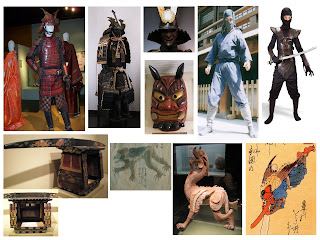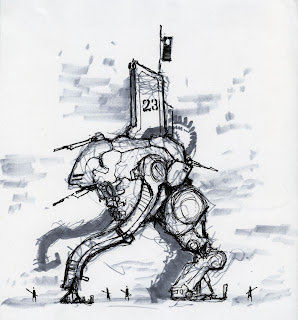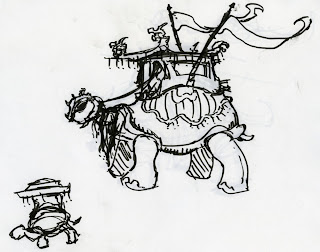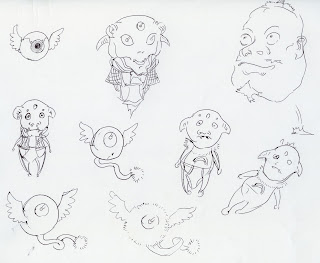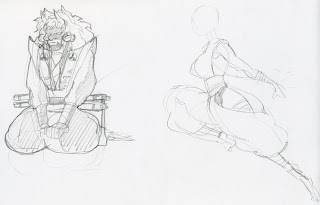Hello! Here's the first post of the blog dedicated to all my teachin', demoin', tutorialin' and learnin'. Stand by for edjamication. One two three GO.
What follows came from the first Design-O-Matic class on the 16th of October. Forty fine people spent a little over an hour cranking out sketches based on reference I provided. They were divided into three groups, one focusing on characters, a second on vehicles and a third on creatures, with me playing Art Director. Design-o-Matic was intended to simulate the kinds of design changes that can happen over the course of game development---at a highly accelerated pace. Games often go through more than one incarnation on their way to completion. The artist must take an old idea and dress it in new clothes, transforming a fantasy pitch into a sci-fi world or turning a gritty, realistic first-person shooter into a more stylized, steam-punk setting. This takes a little getting used to. It demands you sink your energy and passion into the process of creation. You have to hold back from falling in love with your designs until the Art Director (or company principals, whoever has the reins of power) says "THERE! That's our target!"
Even then you have to maintain your discipline and remember a game is a collective effort. You may be the only concept artist on a project. (Lucky you!) Then again, you could be part of a big team composed of full-time staff and a variety of contract people, in-house and not. (This is the norm.) Maybe you'll get to have the first crack at the world. Chances are you'll be expected to work from the creative seeds left behind by others, possibly "blue sky" work from a hired hand early in the development phase, or the accumulated product of a previous team. This is another point Design-O-Matic targeted: getting people used to the idea of working from others' ideas. Every ten minutes we changed subject matter. You had to hand off your sketch to the person to your right and take the sketch from the person on your left, prop it in front of you, and re-interpret that design based on the new reference I provided. Sound crazy? It was, but crazy, like art, often reflects life.
You'll be expected to crank out lots of roughs once you're working out there in the so-called Real World. Quality may take a second seat to quantity. That's okay, so long as the AD can tell what he's looking at. You'll know if your work needs to be tighter or not; you'll be told who's going to see the work and if not, then be sure to ask, just to be on the safe side. ADs are used to seeing ideas in the raw. Producers and other Admin folks, not so much. Remember that as the one with the visual mind, it's your job to interpret your ideas in such a way that they're digestible for your audience. Find out who your audience is before you get rolling. Then start cranking out the goods. Point Three of Design-O-Matic: getting people to focus on quick interpreting and execution. Pretty can come later. Volume first, with clarity as the byword.
Our starting premise was of a first-person-shooter style, gritty, realistic character-driven PC game based in Shogun-era Japan. Samurai vs. Ninja, with demons to boot, inspired by Japanese folklore:
Everyone got ten minutes to crank on that idea. Then came the news down from on high (our imaginary company principals) that we should keep the Asian flavor but make it more fantastic, more "Pan-Asian", and switch it to a straight-up fighting game a la Soul Caliber or Blade and Soul:
Go wild! I told them. Get wacky, push the designs as far from "grounded in realism" as you can get. Then it was time for another bomb. Nope, the principals had changed their minds again. Now they wanted a sci-fi game. The Pan-Asian flavor should stick around, but the target was now something like Lost Planet. Only make the monsters scarier! We've got to one-up the Lost Planet guys! Go!
Then I changed the story again. This work probably got us the deal with EA, I told them, but now that we're effectively a sub-studio of EA and they already have something like this, they'd "prefer" we go in a different direction. Meaning, yep, we're going in a different direction. See, they have this IP they've been sitting on for a kid's open-world sort of game, maybe like Second Life meets Gaia Online or something like that. The only stipulation is that our design work has to stick close to the look of the Intellectual Property:
We had to keep the sci-fi Asian flavor and tweak the tech to suit the universe, but....yeah. Care Bears. Sci-fi Care Bears. And no scary, please, EA and the copyright holders of the Care Bears definitely do NOT want scary. So all those scary monster designs? Un-scare-ify 'em, please. Thank you.
Finally, the last chapter in our story arrived. We got cut loose from the Care Bears IP and asked to develop something with a Shadow-of-the-Colossus flavor. The Principals want to keep the "bears" but turn them into an NPC race. Think "renaissance punk", tech that looks like the progenitor of steam punk. Take the monsters and turn them into giant, animate statues. Get the characters all "midaevaled up". Go!
Starting right here with two from Jessica Dinh, here's what the group produced:
Don't know yet who did the next two:
Unknown:
Unknown:
A trio from Bryant Koshu:
Unknown:
Brian Bedford!
Unknown:
Unknown:
Unknown:
Kyle Jensen:
Unknown:
Unknown:
Ian Jacobson:
Unknown:
Alex Rockman:
Unknown:
Unknown:
Unknown:
Unknown:
Unknown:
The most fabulous Jason Scheier!!
Unknown:
Unknown:
Unkown:
Unknown:
Unknown:
Unknown:
Unknown:
Unknown:
Unknown:
Unknown, and the last for now:
